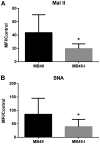Expression of bladder cancer-associated glycans in murine tumor cell lines
- PMID: 30867744
- PMCID: PMC6396118
- DOI: 10.3892/ol.2019.9995
Expression of bladder cancer-associated glycans in murine tumor cell lines
Abstract
The characterization of murine cell lines is of great importance in order to identify preclinical models that could resemble human diseases. Aberrant glycosylation includes the loss, excessive or novel expression of glycans and the appearance of truncated structures. MB49 and MB49-I are currently the only two murine cell lines available for the development of preclinical bladder cancer models. The glycans Lewis X (LeX), Sialyl lewis X (SLeX) and Sialyl Tn (STn) have previously been associated with aggressiveness, dissemination and poor prognosis in human bladder cancer, additionally N-glycolyl GM3 (NGcGM3) is a neo-antigen expressed in many types of tumors; however, to the best of our knowledge, its expression has not previously been assessed in this type of cancer. Taking into account the relevance of glycans in tumor biology and considering that they can act as targets of therapies and biomarkers, the present study evaluated the expression of LeX, SLeX, STn and NGcGM3 in MB49 and MB49-I cells, in different growth conditions such as monolayer cultures, three-dimensional multicellular spheroids and mouse heterotopic and orthotopic tumors. The expression of LeX was not detected in either cell line, whereas SLeX was expressed in monolayers, spheroids and orthotopic tumors of both cell lines. STn was only identified in MB49 monolayers and spheroids. There are no reports concerning the expression of NGcGM3 in human or murine bladder cancer. In our hands, MB49 and MB49-I expressed this ganglioside in all the growth conditions evaluated. The assessment of its expression in cancer cell lines and patient tumors is of great importance, considering the relevance of this ganglioside in tumor biology. The data obtained by the present study demonstrates that glycan expression may be substantially altered depending on the growth conditions, highlighting the importance of the characterization of murine cancer models. To the best of our knowledge, the present study is the first to examine the expression of cancer-associated glycans, in the two murine cell lines available for the development of preclinical studies in bladder cancer.
Keywords: MB49; MB49-I; bladder cancer; glycans; murine models.
Figures






Similar articles
-
A potential role for 6-sulfo sialyl Lewis X in metastasis of bladder urothelial carcinoma.Urol Oncol. 2015 Nov;33(11):496.e1-9. doi: 10.1016/j.urolonc.2015.05.026. Epub 2015 Jun 29. Urol Oncol. 2015. PMID: 26137907
-
Cytogenetic characterization of the murine bladder cancer model MB49 and the derived invasive line MB49-I.Cancer Genet. 2012 Apr;205(4):168-76. doi: 10.1016/j.cancergen.2012.02.002. Cancer Genet. 2012. PMID: 22559978
-
Novel invasive orthotopic bladder cancer model with high cathepsin B activity resembling human bladder cancer.J Urol. 2009 Aug;182(2):749-55. doi: 10.1016/j.juro.2009.03.076. Epub 2009 Jun 18. J Urol. 2009. PMID: 19539312
-
Glycosylation characteristics of colorectal cancer.Adv Cancer Res. 2015;126:203-56. doi: 10.1016/bs.acr.2014.11.004. Epub 2015 Feb 7. Adv Cancer Res. 2015. PMID: 25727149 Review.
-
The glycosylation landscape of pancreatic cancer.Oncol Lett. 2019 Mar;17(3):2569-2575. doi: 10.3892/ol.2019.9885. Epub 2019 Jan 3. Oncol Lett. 2019. PMID: 30854032 Free PMC article. Review.
Cited by
-
Establishment of new transurethral catheterization methods for male mice.Biol Methods Protoc. 2024 Feb 5;9(1):bpae005. doi: 10.1093/biomethods/bpae005. eCollection 2024. Biol Methods Protoc. 2024. PMID: 38414648 Free PMC article.
-
Antifungal immunity mediated by C-type lectin receptors may be a novel target in immunotherapy for urothelial bladder cancer.Front Immunol. 2022 Sep 5;13:911325. doi: 10.3389/fimmu.2022.911325. eCollection 2022. Front Immunol. 2022. PMID: 36131933 Free PMC article.
-
Controllable Assembly of Upconversion Nanoparticles Enhanced Tumor Cell Penetration and Killing Efficiency.Adv Sci (Weinh). 2020 Nov 7;7(24):2001831. doi: 10.1002/advs.202001831. eCollection 2020 Dec. Adv Sci (Weinh). 2020. PMID: 33344124 Free PMC article.
-
Antitumor effects of the GM3(Neu5Gc) ganglioside-specific humanized antibody 14F7hT against Cmah-transfected cancer cells.Sci Rep. 2019 Jul 9;9(1):9921. doi: 10.1038/s41598-019-46148-1. Sci Rep. 2019. PMID: 31289278 Free PMC article.
-
Electrochemical Evaluation of Tumor Development via Cellular Interface Supported CRISPR/Cas Trans-Cleavage.Research (Wash D C). 2022 Apr 6;2022:9826484. doi: 10.34133/2022/9826484. eCollection 2022. Research (Wash D C). 2022. PMID: 35474904 Free PMC article.
References
-
- Tabayoyong W, Gao J. The emerging role of immunotherapy in advanced urothelial cancers. Curr Opin Oncol. 2018;30:172–180. - PubMed
LinkOut - more resources
Full Text Sources
Research Materials
